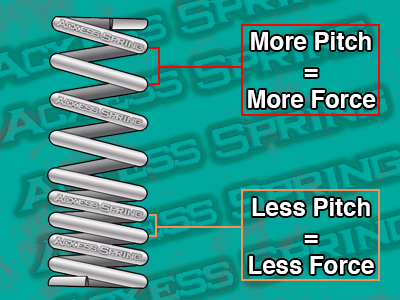Non-Linear Springs
- Non-Linear Springs Definition
- Non-linear springs are helical coil springs that exert an inconsistent amount of force as it is under a working load or torque. This means that the force needed to travel one inch, millimeter, or degree might not double when it travels two inches, millimeters, or degrees like a linear spring would.
There are several types of non-linear springs in compression, extension, and even torsional spring forms. These include conical/tapered springs, barrel springs (concave and convex), and dual-pitch springs.
Non-Linear Springs #1
Due to the change in outer diameter of each coil, the force each coil will exert will be different; smaller coils will produce more force. This is what makes conical and tapered springs non-linear. The narrowing of each coil makes the spring index of this non-linear spring tighter. Therefore, it exerts more force and does not execute a constant rate of force per distance traveled. Torsional springs may also be made into a conical tapered form in rare cases.
Conical springs are usually used to make more space for more travel due to the telescope effect they are able to achieve when being compressed which allows for the solid height to be lowered. You achieve this by making the outer diameter of each coil smaller than the previous one to make a conical / tapered shape. You might find non-linear conical springs which don’t have a telescope effect because tapered springs also allow the spring to have more stability in case you happen to have a normal compression spring with a long free length in proportion to its outer diameter which would cause the spring to buckle or bend when being compressed.
Conical/Tapered Springs

Non-Linear Springs #2
Barrel compression springs are very similar to conical compression springs since the diameters of the coils become tighter as the spring ascends. In the case of barrel compression and extension springs though, the body of the spring forms a convex or concave shape. A convex spring will have a larger outer diameter in the center coil and the coils in the ends will have the smaller outer diameter while a concave spring will have a smaller outer diameter in the center coil and larger diameters on the end coils. Barrel extension springs will usually be convex. These springs are primarily used to provide stability but may also be designed to perform a telescope effect when the barrel compression spring is being compressed.
Barrel springs are also non-linear due to the changing diameters of the coils. Like conical springs, the smaller coils will have more force than those that are larger. These non-linear springs will be most convenient if you have a barrel compression spring that runs the risk of buckling when compressed and it isn’t going to be installed over a shaft or inside a hole.
Barrel Springs (Convex and Concave)

Non-Linear Springs #3
Dual pitch springs are non-linear compression springs with different amounts of pitch between coils in different sections of the spring. Coil pitch is key to your spring’s load and travel capacities. The more pitch between the coils, the more force you obtain as well as stress on your compression spring. This is why some springs with very little coils and a lot of pitch will not travel all the way down to solid height; they have very little deflection or travel.
Non-linear dual pitch springs may be used when you need to meet two loads on your spring that you aren’t able to meet with a constant spring rate. This requires you to adjust the pitch in between some of the coils for it to take you to a different amount of load to meet your required loaded heights.
Dual Pitch Compression Springs





 Español
Español